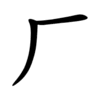厂
| ||||||||
Translingual
| Stroke order | |||
|---|---|---|---|
 | |||
Han character
厂 (radical 27, 厂+0, 2 strokes, cangjie input 一竹 (MH), four-corner 71200, composition ⿱一丿)
- Kangxi radical #27, ⼚.
Derived characters
- Index:Chinese radical/厂
- 屵
References
- KangXi: page 160, character 15
- Dai Kanwa Jiten: character 2890
- Dae Jaweon: page 366, character 21
- Hanyu Da Zidian: volume 1, page 67, character 16
- Unihan data for U+5382
Chinese
Glyph origin
| Historical forms of the character 厂 | |||
|---|---|---|---|
| Shang | Western Zhou | Shuowen Jiezi (compiled in Han) | Liushutong (compiled in Ming) |
| Oracle bone script | Bronze inscriptions | Small seal script | Transcribed ancient scripts |
 |
 |
 |
 |
| Characters in the same phonetic series (厂) (Zhengzhang, 2003) | |
|---|---|
| Old Chinese | |
| 厂 | *hŋaːnʔ, *hŋaːns |
| 屵 | *ŋaːd |
Etymology 1
| For pronunciation and definitions of 厂 – see 廠 (“shack; shed; etc.”). (This character, 厂, is the simplified form of 廠.) |
Notes:
|
Etymology 2
| simp. and trad. |
厂 | |
|---|---|---|
| variant forms | 厈 | |
From the stem *ŋaʔ (“to oppose; to resist”), i.e. “that which resists (the river's flow)”, with a voiceless initial (used to signify that that the noun refers to a natural object) and a general noun suffix *-n; related to 岸 (OC *ŋɡaːns, “bank; shore”), 滸 (OC *hŋaːʔ, “riverbank”) (Schuessler, 2007).
Pronunciation
Pronunciation
Etymology 4
| For pronunciation and definitions of 厂 – see 䉷 (“object for hiding when shooting birds; imperial garden”). (This character, 厂, is a variant form of 䉷.) |
Usage notes
- As a component of other characters, 厂 can be referred to as 偏廠兒/偏厂儿 (piānchǎngr) or 廠字頭/厂字头 (chǎngzìtóu).
Japanese
Korean
Vietnamese
Han character
厂
References
This article is issued from
Wiktionary.
The text is licensed under Creative
Commons - Attribution - Sharealike.
Additional terms may apply for the media files.